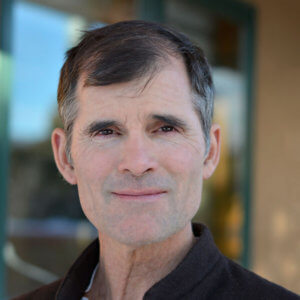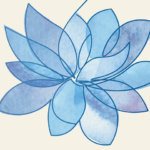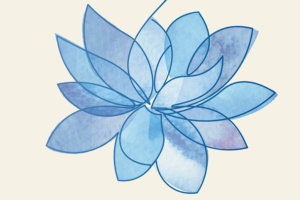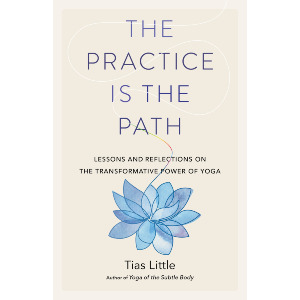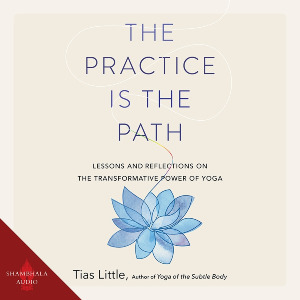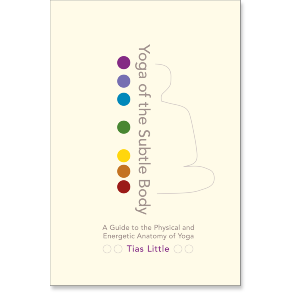Practices for On and Off the Mat
On the Mat
Be All Ears
Begin in child’s pose (balasana). Set your knees hip-width apart and stretch your arms straight out in front of you on the floor, in the same way you stretch your arms in downward dog pose. Either support your forehead on the floor, or rest your head on a block or blanket. Enter the pose with beginner’s mind—that is, “be all ears” and listen to the small, ongoing shifts that take place in your body. Note that every breath, every sensation is new. Scan your body for sensations and note whether your sensations are intense or mild. Observe where in your body you feel restriction. Explore the limitation or barrier within the stretch with a spirit of curiosity. Then note the places in your body where you feel ease and space. Where does it feel pleasant? Allow your awareness to absorb into the region of your body where you feel a positive sensory response.
Ask yourself, How does the interior of my pose change?
Note the feeling in your front hip crease, lower back, shoulders, arms, and hands.
Sense and feel any ongoing shifts within your breath, in the stretch of your fascia, the weight of your bones, and the contact of your skin. Be like a meteorologist, observing the changing “weather” in the pose; notice places of high pressure and low pressure. As blood infuses into your tissues, sense changes in the humidity levels of your body. Note any atmospheric changes in your neck and skull. Stay here for two minutes.
Now lie on your back in savasana with a blanket folded to a height of two inches tucked under your head. As you rest in stillness, note the pulses in your hands and wrists. Like a doctor of Ayurveda or Chinese medicine, take your own pulse by observing the pulses in your right and left wrists. Are your pulses more rapid or amplified on one side? Do they feel shallow, thin, wiry, flat, or thick? Note the way the back of your body drops into the floor. Imagine that your organs are like small water balloons, spreading as they release. Listen to the rise and fall of your breath and the weight of your ribs against the floor. What sensations can you feel in your chest? Sense the dance between your respiratory rhythm and your heart rate. Can you feel any pulses within your cranium? Visualize your brain suspended in fluid, held in place by sturdy ligamentous moorings. Sense the biodynamic pulse of your brain tissue as it continuously expands and narrows in response to the craniosacral rhythm.
Be like an ocean and sense the perpetual sway of circulating currents in your bloodstream, lymphatic channels, and nerve endings.
Sense the fluid potency of all the cells and tissues of your body. Be all ears as you listen inwardly to the vital flow of prana through your blood and nerve channels (nadis)—circulating, evanescent, motile. Note the rise and fall of the waves of your breath. Absorb into the interior of your body that is always changing, always new. Stay here for five to ten minutes.
Off the Mat
At the Trailhead of the Eightfold Path
In the early Buddhist teachings, the path of the mind-heart is mapped with eight distinct routes. Each trail guides us from the ingrown, obsessive, myopic city of self into the raw power of the wilderness. On the trail we are not meant to fret about whether we have the right gear or ample food or worry about whether there are deadly snakes on the trail.
This path is about being fearless in the open air, under the big sky.
At the trailhead to the Eightfold Path, right at the get-go, the first trail posting is called Right View. Right View is perhaps better translated as Total View, or Big Vista—like a drone shot taken from above, you have to see the entire terrain. The first leg of the journey requires that you see all dharmas—all things—as impermanent, like drops of morning dew, flashes of lightning, or clouds. Each experience is like a cloud, gathering together and dispersing in time. You might recall cloud gazing and imagine seeing a seahorse, a gorilla, a young princess in the configuration of a cloud. The spectacle forms and within moments vanishes. In Total View, we come to see that everything is in the process of change. We realize too that everything is interconnected and that there is no such thing as a “me” separate from the ecology that surrounds me. In Total View we come to see everything anew.
As you set out on the path of your day, have the intention to live each instant with fresh eyes. This is the second trail posting of the Eightfold Path, Right Intention, or what I like to refer to as Yoked Intention. In your day have an altruistic motivation to be kind, to abandon negativity, and to practice nonclinging. Resolve to see every perception, thought, word, and deed as droplets of water, droplets of time, in the always new. In the Eightfold Path, each ensuing trail posting—Right Speech, Balanced Action, Right Livelihood, Balanced Effort, Total Mindfulness, and Yoked Concentration—leads away from habitual, self-centered, and neurotic tendencies. Move slowly, listen with care, and have loving attention.
Be open to the always new and to the wondrous and strange grace of the world.
Share
More About the Author of The Practice is the Path
